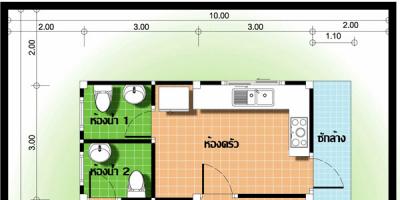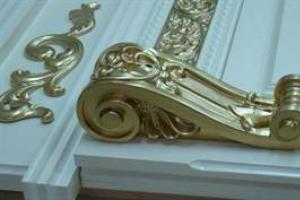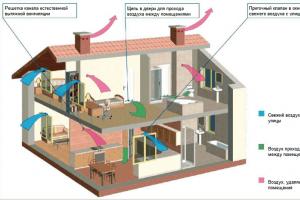In this article I will tell you how to make a dial tester out of a smartphone. electrical circuits for a break or short circuit. In fact, I'll make a console for cell phone(rather, even an adapter with probes), with which you can take measurements. Its circuit is incredibly simple and contains one resistor.
This craft may come in handy if your working multimeter is broken. Or you don't want to take it with you. Personally, I made such an adapter-attachment and threw it in the glove compartment of the car. Now, when I need to ring a light bulb, fuse or something else, I take out the probes and connect them to the phone.
What capabilities does a smartphone tester provide?
With this tester you can:- - Check the circuit for an open or short circuit.
- - Find out the approximate resistance value (0-70 Ohm).
- - The smartphone makes a sound when continuity is detected.
Adapter-attachment diagram
Pinout of headset jack pins.
We will feed the signal from the probes to the microphone input.

Everything can be done by surface mounting by soldering a resistor to the plug, soldering the wires and filling the whole thing with hot glue. Or make a separate unit with a split for the probes, put on heat shrink and blow it off. IN as a last resort use electrical tape. 15 minutes of work, no more...

Smartphone app
After the adapter is soldered, download the application from (active link to the application) and install it.Launch the application and connect the adapter. Everything should work. If you close the probes, you will hear a beep, which means everything is fine and you can use it.
Initially zeros are shown:

And when you close the probes together, this word appears and the phone beeps.

Caution when using the tester
This tester cannot measure circuits where there is voltage! Because your smartphone may fail. Also keep in mind that in some circuits there may be residual voltage on the device’s capacitors, which will also be dangerous for the smartphone.Sometimes a thing is very necessary and useful in the household.
Smartphones have long been part of our lives and are being used more and more.
Studying on various works servicing electronic equipment, I have accumulated several multimeters. The reason for the accumulation is simple. The power of a working multimeter quickly ran out if you forgot to turn off the power in a hurry, and without such a device, on-site repairs sometimes became impossible. There was only one way out - urgently change the battery. But, probably, many will agree that it is easier to buy a new multimeter than to find a Krona battery, especially since the price of a new multimeter is slightly more than a brand-name battery. It's strange that there are still no multimeters with low voltage supply. Let's fill this gap. Let's consider an example of powering a multimeter from an AA battery using a previously published voltage converter.
How to power a multimeter from a 1.5 Volt battery with your own hands
Capacitor voltage
Test multimeter
An antique multimeter was taken for testing. To avoid high voltage from the capacitor, power from the converter was supplied to the switched on multimeter. Surprisingly, the multimeter started working, showing the supply voltage from the converter as 12 Volts. The multimeter also worked from a 0.7 volt battery - the supply voltage was 4.7 volts, although the icon of a dead battery was on. Having installed a dead battery with a voltage of 1 Volt in the converter, the multimeter received a standard power supply of 9 Volts.
To form a complete design, it is necessary to integrate the converter into the multimeter, especially since the dimensions of the battery compartment and parts allow this to be done. You can organize the switching on from a separate switch, or you can try to use a standard power switch. This multimeter succeeded; all traces of the biscuit switch were illuminated. The changes to the scheme were as follows:
— the 9 Volt power supply paths were cut immediately behind the switch;
— power supply paths are connected by a jumper;
— a 100 μF electrolytic capacitor is installed in the 9 Volt power bus of the multimeter;
— extension conductors are soldered to the battery and they are connected to the standard power supply terminals for the multimeter;
— immediately behind the biscuit switch, a conductor is soldered from which voltage will be supplied to the converter;
— the conductor from the converter diode is soldered to the “plus” of the capacitor;
— solder the minus power supply conductor of the converter to the minus power supply bus of the multimeter.
Trimming board tracks
Electronics layout
The circuit is assembled by surface mounting and secured with hot-melt adhesive in the battery compartment. So, quite unexpectedly, the old multimeter got a second life, and even from a dead battery :).
The circuit can be modified by installing a 9-volt Zener diode in parallel with the capacitor, which will allow the use of fresh batteries.
The Master's Secret recommends a universal multimeter for use in work UNI-T UT210E with current clamps allowing measurements to be taken at direct current. A very convenient device. Multimeter UNI-T UT210E at the best price purchased in the online store at the following price
Those who like to do it themselves are offered a simple tester based on the M2027-M1 microammeter, which has a measurement range of 0-300 μA, internal resistance of 3000 Ohms, accuracy class 1.0.
Required Parts
This is a tester that has a magnetoelectric mechanism to measure current, so it only measures DC current. The moving coil with an arrow is mounted on guy wires. Used in analog electrical measuring instruments. Finding it at a flea market or buying it at a radio parts store won’t be a problem. There you can also purchase other materials and components, as well as attachments for the multimeter. In addition to the microammeter you will need:
If a person decides to make himself a multimeter with his own hands, it means that he has no other measuring instruments. Based on this, we will continue to act.
Selecting measurement ranges and calculating resistor values
Let us determine the range of measured voltages for the tester. Let's choose the three most common ones, covering most of the needs of radio amateurs and home electricians. These ranges are from 0 to 3 V, from 0 to 30 V and from 0 to 300 V.
The maximum current passing through a homemade multimeter is 300 μA. Therefore, the task comes down to selecting an additional resistance at which the needle will deflect to full scale, and a voltage corresponding to the limit value of the range will be applied to the series circuit Rd + Rin.
That is, on the 3 V range Rtot=Rd+Rin= U/I= 3/0.0003=10000 Ohm,
where Rtot is the total resistance, Rd is the additional resistance, and Rin is the internal resistance of the tester.
Rd = Rtot-Rin = 10000-3000 = 7000 Ohm or 7 kOhm.
On the 30 V range the total resistance should be 30/0.0003=100000 Ohm
Rd=100000-3000=97000 Ohm or 97 kOhm.
For the 300 V range Rtot = 300/0.0003 = 1000000 Ohm or 1 mOhm.
Rd=1000000-3000=997000 Ohm or 997 kOhm.
 To measure currents, we will select the ranges from 0 to 300 mA, from 0 to 30 mA and from 0 to 3 mA. In this mode, the shunt resistance Rsh is connected to the microammeter in parallel. That's why
To measure currents, we will select the ranges from 0 to 300 mA, from 0 to 30 mA and from 0 to 3 mA. In this mode, the shunt resistance Rsh is connected to the microammeter in parallel. That's why
Rtot=Rsh*Rin/(Rsh+Rin).
And the voltage drop across the shunt is equal to the voltage drop across the tester coil and is equal to Upr=Ush=0.0003*3000=0.9 V.
From here in the range 0...3 mA
Rtotal=U/I=0.9/0.003=300 Ohm.
Then
Rsh=Rtot*Rin/(Rin-Rtot)=300*3000/(3000-300)=333 Ohm.
In the range of 0...30 mA Rtot=U/I=0.9/0.030=30 Ohm.
Then
Rsh=Rtot*Rin/(Rin-Rtot)=30*3000/(3000-30)=30.3 Ohm.
From here, in the range of 0...300 mA Rtot=U/I=0.9/0.300=3 Ohm.
Then
Rsh=Rtot*Rin/(Rin-Rtot)=3*3000/(3000-3)=3.003 Ohm.
Fitting and installation
To make the tester accurate, you need to adjust the resistor values. This part of the work is the most painstaking. Let's prepare the board for installation. To do this, you need to draw it into squares measuring a centimeter by a centimeter or a little smaller. Then, using a shoemaker's knife or something similar, the copper coating is cut along the lines to the fiberglass base. The result was isolated contact pads. We noted where the elements would be located, and it looked like a wiring diagram right on the board. In the future, tester elements will be soldered to them.

In order for a homemade tester to give correct readings with a given error, all its components must have accuracy characteristics that are at least the same, or even higher. We will consider the internal resistance of the coil in the magnetoelectric mechanism of the microammeter to be equal to 3000 Ohms stated in the passport. The number of turns in the coil, the diameter of the wire, and the electrical conductivity of the metal from which the wire is made are known. This means that the manufacturer’s data can be trusted.
But the voltages of 1.5 V batteries may differ slightly from those declared by the manufacturer, and knowledge of the exact voltage value will then be required to measure the resistance of resistors, cables and other loads with a tester.
Determining the exact battery voltage
In order to find out the actual battery voltage yourself, you will need at least one accurate resistor with a nominal value of 2 or 2.2 kOhm with an error of 0.5%. This resistor value was chosen due to the fact that when a microammeter is connected in series with it, the total resistance of the circuit will be 5000 Ohms. Consequently, the current passing through the tester will be about 300 μA, and the needle will deflect to full scale.
I=U/R=1.5/(3000+2000)=0.0003 A.
If the tester shows, for example, 290 µA, then the battery voltage is
U=I*R=0.00029(3000+2000)=1.45 V.
Now knowing the exact voltage on the batteries, having one exact resistance and a microammeter, you can select the required resistance values of the shunts and additional resistors.
Assembling the power supply
The power supply for the multimeter is assembled from two 1.5 V batteries connected in series. After this, a microammeter and a 7 kOhm resistor pre-selected at nominal value are connected to it in series. The tester should show a value close to the current limit. If the device goes off scale, then a second, small value resistor must be connected in series to the first resistor. If the readings are less than 300 μA, then a large value resistance is connected in parallel to these two resistors. This will reduce the total resistance of the additional resistor. Such operations continue until the needle reaches the scale limit of 300 μA, which signals an accurate fit.

To select the exact 97 kOhm resistor, select the closest one that matches the nominal value, and follow the same procedures as with the first 7 kOhm one. But since a 30 V power source is required here, the multimeter’s power supply will need to be reworked from 1.5 V batteries. A unit with an output voltage of 15-30 V is assembled, as long as it is enough. For example, if it turns out to be 15 V, then all adjustments are made on the basis that the needle should tend to read 150 μA, that is, half the scale. This is acceptable, since the tester scale when measuring current and voltage is linear, but it is advisable to work with full voltage.
To adjust the additional resistor of 997 kOhm for the 300 V range, generators will be needed direct current or tension. They can also be used as attachments to a multimeter when measuring resistance.
Resistor values: R1=3 Ohm, R2=30.3 Ohm, R3=333 Ohm, R4 variable at 4.7 kOhm, R5=7 kOhm, R6=97 kOhm, R7=997 kOhm. Selected by fit. Power supply 3 V. Installation can be done by hanging elements directly on the board. The connector can be installed on the side wall of the box into which the microammeter is embedded. The probes are made of single-core copper wire, and the cords for them are made of stranded copper wire.
The shunts are connected using a jumper. As a result, a microammeter turns into a tester that can measure all three main parameters of electric current.
Probes are an integral part of all multimeters, which comes complete with the measuring device, regardless of its model. Good probes have been performing their task well for many years. But it also happens that a few days after purchasing a multimeter, one or even both contacts fail due to a broken wire, broken tip or cracked insulation. To protect yourself from such a nuisance, you need to purchase high-quality and reliable multimeter probes, with good wires and durable tips. Many people prefer to make them themselves. In this material we will talk about the varieties and features of these elements, and also figure out how to make homemade probes for a multimeter.
Universal probes
These products are the simplest and cheapest. They are included with most inexpensive multimeter models. The cables of these elements are equipped with PVC insulation, and the plugs and lug holders are made of plastic. A thin wire is attached to the steel electrode from inside the holder. Such tips can easily come off if not handled carefully. It is clear that there is no need to talk about durability and high reliability here.

Different models of universal contacts have unequal lengths of the central electrode of the plug and the protruding part of its body. They also differ in the mounting depth of the plug.
Branded products
The multimeter may have a probe made of various materials. High-quality and reliable contacts can be distinguished by the following characteristics:
- Multimeter probe leads are made of highly flexible material.
- The holder insertion is flexible and sealed. The vein in it holds tightly and does not give in to random jerks.
- The surface of the product near the base of the holder does not slip and can be comfortably held with your fingers during measurements. The best option– holder with rubberized surface.
The video shows an example of such products:
Everyone listed properties have silicone probes. These parameters are responsible for the high popularity of such products.
Often the holder inputs are made of plastic, but in this case they must have special recesses, otherwise the element will not have the required flexibility. On almost all branded models, plugs and electrodes are equipped with caps that protect the elements from contamination and minimize the possibility of puncture injuries.

These products were developed taking into account the experience of using earlier models, and therefore are distinguished by their thoughtfulness and ease of use. The wire of such contacts has sufficiently high strength and flexibility, is resistant to accidental jerks and does not crack when bent.
Probes for SMD mounting
When working with SMD elements, it is periodically necessary to carry out measurements, which can only be done using thin probes connected to the tester. These products are equipped with sharp brass or stainless steel needle-shaped tips. They are necessarily protected with caps, which minimize the risk of electrode fracture or accidental injury to the technician.
For SMD installation specialists, such elements are most convenient to use. With sharp probes you can not only pierce the wire insulation, but also scrape off the solder mask from the desired area of the board surface and then carry out measuring work. Although the thickness of this needle is very small, the element can easily withstand a voltage of 600 V for a long time.
For measuring work when installing SMD components, multimeter probes are also provided. They allow you to measure the required parameters of a part both on the desktop and directly on the board.

During the measurement, the component is clamped with pliers, which guarantees the quality of the contact. These products have a fairly short cable, but a long one is not needed to work with SMD.
If the measurement process requires maximum care to prevent the electrode from touching other parts, then it is best to use probes with holes at the ends.
With their help, you can make measurements as printed circuit boards, and during electrical installation work without fear of accidentally causing a short circuit.
Crocodile tips
This version of the tip is also available on the modern market and is in considerable demand. In some cases, it turns out to be preferable to sharp electrodes. The size of the “crocodile” may vary, but in any case it must have a reliable shell made of dielectric material.
Connecting tips can be made in the form of “crocodiles”, serving as additional element for a standard probe. Often, the kit for the multimeter includes tips in the form of clip-on “crocodiles”, which, if necessary, can be either detached or attached.

It is also necessary to mention the kits, which include several different tips. When starting work, the master himself selects the one he needs and screws it in like an attachment. This feature allows in some cases to significantly simplify the measurement process. So, for example, a crocodile can be connected in turn to different sections of the electrical circuit being tested, while the other tip is attached to ground as a terminal.
Technicians who work with terminal components prefer terminals designed in the form of clips and hooks. With the help of such elements it is convenient to carry out measuring work on printed circuit boards, as well as to hold the terminal components in place during measurements. These tips, as well as needles and crocodiles, can be included in the delivery package.
How to make homemade probes?
As we said above, many people prefer not to buy new ones when factory probes break down, but to make them themselves. Let's consider two popular options for making homemade products.
Standard homemade probes
To make them you will need dismountable fountain pens (without refills) and dart tips for darts.

The operating procedure is as follows:
- Disassemble the fountain pens and try on dart tips for them.
- Having selected the appropriately sized components, insert the dart tips into the handles instead of the rods, after heating them with a gas burner.
- Place a piece of solder inside the handle, after moistening it with soldering acid and heating it.
- Place the cable there.
- Wait until the solder cools down and the probe elements are fixed.
For additional fixation, the dart tip can be glued.
The entire device is clearly shown in the video:
Thin homemade probes for piercing insulation
Now let's figure out how to make thin probes for a multimeter with your own hands. To do this, we will need collet pencils using replaceable leads, and sewing needles of suitable thickness.
The production of thin probes is carried out as follows:
- Solder the cables to the needles.
- Insert the needles inside the pencils until they hit the center of the collet. To prevent them from going inward when pressed, they should be glued into the collet.
- Solder the plugs to the cables.

It is advisable to apply colored heat shrink to the resulting products. When working with a hair dryer, you need to be careful, as the flow of hot air can cause deformation of the plastic.
Pen and pencil caps can be used as protective elements.
The video shows an example of making needle probes for checking small parts:
Conclusion
From this article you learned what tester probes are needed for, what types of these products there are and what are the features of their use. Well, for those who like to assemble on their own electrical devices and products, you will probably be interested in information on how to make multimeter probes with your own hands.
The Chinese yellow tester DT-830B from Leroy-Merlin costs 75 rubles. It has an LCD display, a microcircuit like ICL7106/7106 in the form of a drop of epoxy with a strap and why not make a convenient built-in voltmeter out of it for, for example, a power supply, or some other application, simply cutting off the unnecessary.
You need a voltmeter - remove everything unnecessary
Original
The original looked like this (yes, I forgot the cords! They are also worth something).What's in the package
What is inside
We analyze, study, draw conclusions:

Schematic diagram
Here is a schematic diagram of the “father of the family”, which can be seen in many similar devices with minor variations. Often even the markings on the board coincide with the positional designations on the diagram (R3, C6...):
The scheme, of course, does not coincide 1:1 with reality, but you get the gist enough.
Printed circuit board
Printed circuit board in “printable” form, I studied the tracks on it:
Rework
Trimming and jumpers
In general, take scissors and cut along the path above the inscription “830B.4C”.Then you will need to restore just one connection using jumper A-A and use the second jumper B-B to indicate how to display commas on the screen. See further:

Comma management
| 1. jumper from "BATT +" (upper pin R8) to lower pin R2. The result will be like this: | 
|
| 2. jumper from "BATT +" (upper pin R8) to lower pin R3. The result will be like this: |
|
| 3. jumper from "BATT +" (upper pin R8) to lower pin R4. The result will be like this: |
|
| 4. If the jumper is not installed at all, the “HV” icon will not be displayed. |
|
As you can see, commas are very easy to manage. At least a switch (if necessary, of course).
In its original case, the resulting “multimeter stub” now looks like this:


Divider for voltmeter
There are unused precision resistors left on the sides of the board - they can be used to organize the desired voltage divider for a voltmeter:| position | denomination | divider | range 1 (voltmeter resistance input) | range 2 (voltmeter resistance input) |
| R22 | 100 | 1:1 | 0 - 200 mV / 0.1 kOhm | not Spanish |
| R21 | 900 | 1:10 | 0 - 2 V / 1 kOhm | 0 - 200 mV / 1 kOhm |
| R13 | 9k | 1:100 | 0 - 20 V / 10 kOhm | 0 - 2 V / 10 kOhm |
| R14 | 90k | 1:1000 HV | 0 - 200 V / 100 kOhm | 0 - 20V / 100 kOhm |
In order to use the divider, you need to connect the lower pin R22 to the “COM” bus (for example: the upper pin C3 or the lower pin R7). Connect the input of the microcircuit to the desired divider tap (connect the upper pin R6 to the lower pin R21 if range 1 is selected or to the upper pin R21 if range 2 is selected). The difference in the choice of ranges will be in the input resistance of the resulting voltmeter. Resistors R1 100 Ohm and R2 900 Ohm cannot be touched, they are used. Resistor R9 is not used. It can even be removed; but you can't connect to it.
What happened as a result
In essence, it turned out to be a measuring head, also known as a digital DC voltmeter, with the following parameters:- input voltage range -199-0-199 mV (both polarities are measured with sign indication);
- overload indication;
- linearity error no more than ±0.2 units;
- zero setting error no more than ±0.2 units;
- input current no more than 1pA (typical value for ICL7106/7107), corresponding to the value input impedance guaranteed in hundreds of megaohms;
- The current consumption of the voltmeter is about 1 mA on each arm, which corresponds to hundreds of hours of operating time from the standard “Krona”.
- The low-pass filter at the input (R6 1Mohm and C3 0.1uF) provides a settling time of 0.1 sec.
If you need to power the voltmeter from the device where it will be installed, you should take into account that the voltage at the “BATT+” pin of the microcircuit (relative to “COM”, of course) will always be 3.0V because it is stabilized by the internal reference stabilizer in the microcircuit itself and cannot be exceeded; the negative voltage “BATT-” is formed as the voltage on the battery minus 3.0V. Both voltages can be formed by parametric stabilizers using two resistors and any zener diode, even a green one or, better yet, a white LED. But the best thing is to provide a galvanically independent power source for the voltmeter, especially since the current consumption is negligible.
Application
Thermometer -55...+150С with resolution 0.1С
As a sensor we use the LM35 sensor chip in the following connection:


The estimated price of the microcircuit is about 200 rubles ($6) for LM35CZ.
Schematic diagram of a thermometer
Operating temperature range, error and chip index
| marking* | temperature range | typical error at 25C** | TO-46 body | TO-92 body | SO-8 housing (SMD) | housing TO-220 |
| LM35 | -55...+155 | 0.4 | LM35H | |||
| LM35A | -55...+155 | 0.2 | LM35AH | |||
| LM35C | -40...+110 | 0.4 | LM35CH | LM35CZ | ||
| LM35CA | -40...+110 | 0.2 | LM35CAH | LM35CAZ | ||
| LM35D | 0...+100 | 0.4 | LM35DH | LM35DZ | LM35DM | LM35DT |
Note:
*index A means improved accuracy and linearity.
**at the edges of the range the error is approximately 2 times higher, for more details see











